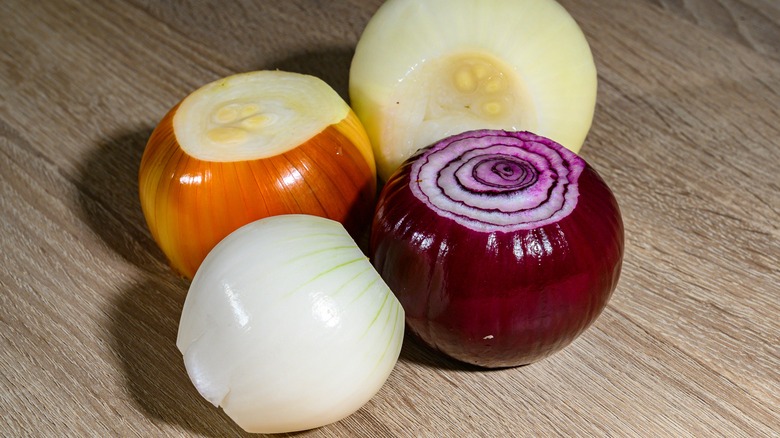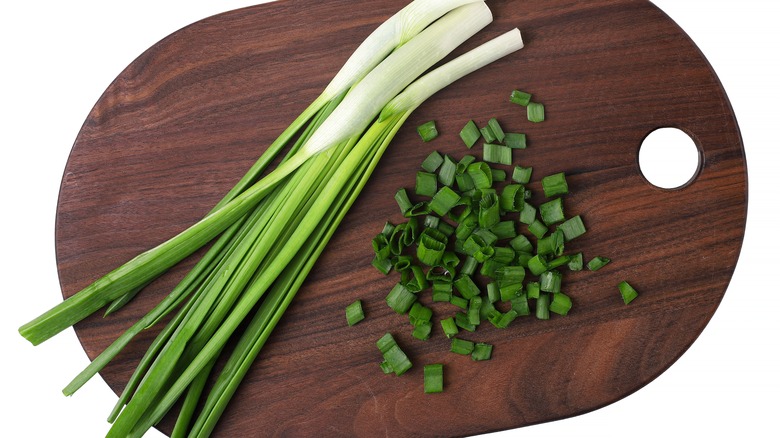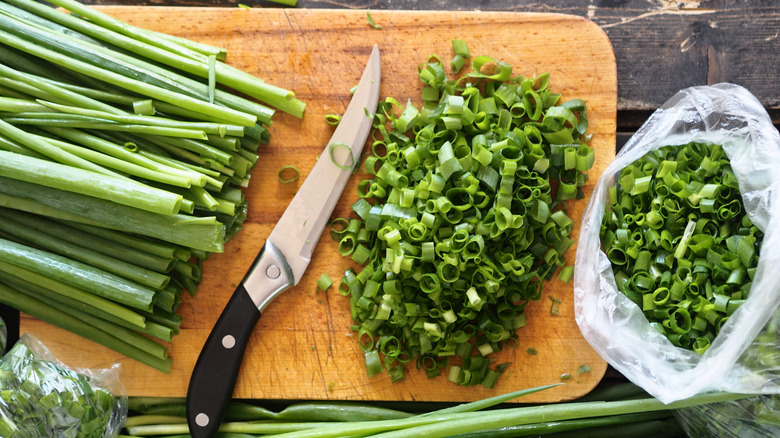Onions Have Layers. Here Are The Differences Between Some Favorites
As our dear Shrek would say, "Onions have layers." So, while one green ogre may look like the other, each is unique with distinct characteristics. The same goes for green onions. Green onions, like green ogres, tend to get clumped together in a bunch, literally and figuratively, but there are critical differences between these onion varieties.
Ah, the many layers of oh-so-many onions. Hardy softball-sized yellow onions are great for cooking roasts, sauces, stews, and stir-fries, as their high starch content allows them to hold their shape and withstand a hot sizzle better than other onions. Equally large red onions are a favorite eaten raw in sandwiches and salads, and they are an excellent choice for pickling and grilling, too. As for yummy fried onion rings, sweet varieties work well, and salsas and chilis are taken to the next level with white onion. But what about those green onions we mentioned earlier?
Different types of green onions
When we think about green onions, we typically think of the most common kind with the long, cylindrical stalks and small, white bulbs. You know, the kind we get at the market with good intentions but then forget about until the stalks become mushy (a little advice: remove any rubber bands from the bunch to delay mushiness). But there is more than one type of green onion.
Green onions and scallions are often mistaken for each other, and honestly, it makes sense. Scallions are basically the younger, milder version of the green onion. Green onions are kept in the ground longer until they grow a white bulb, and while scallions and green onions can be found year-round, they are naturally plentiful in spring and summer.
Now that brings us to spring onions, which can also be confused with the standard green onion. Spring onions are usually thinner and have a larger white bulb prized for their flavor.
The perfect baked potato would not be complete without a sprinkling of fresh chives. This little allium looks like a green herb or fine blade of grass, and it can be a suitable substitute for the stalks of green onions.
Leeks are like gentle giants among green onions. Large and sturdy, yet mellow in flavor, leeks lend themselves to hot dishes like soothing soups.
How to handle green onions
Green onions have a milder flavor than their yellow, red, and white cousins, so they are often the alliums of choice for people who order their sandwiches and pizzas with "No onions, please." Home chefs who want to avoid crying over chopped onions also welcome mild green varieties.
The white bulbs of green onion varieties are usually more pungent and heartier than their long green stalks. The green stalks can generally be enjoyed raw, while the bulbs can withstand some heat and still shine. The green stalks can be cooked, too, but the texture will soften significantly, and the flavor will be even milder — which can be delicious for the right dish.
And while green onions are milder than others, they still carry a definite pungency, and other items in your fridge can absorb that onion smell and taste. Fresh fruit with the aroma of green onions is not a flavor combo we recommend. To avoid this mini catastrophe, you must be careful that your green onions are stored in their airtight container. Other than that, you are now set to discover the many layers of the onion!


